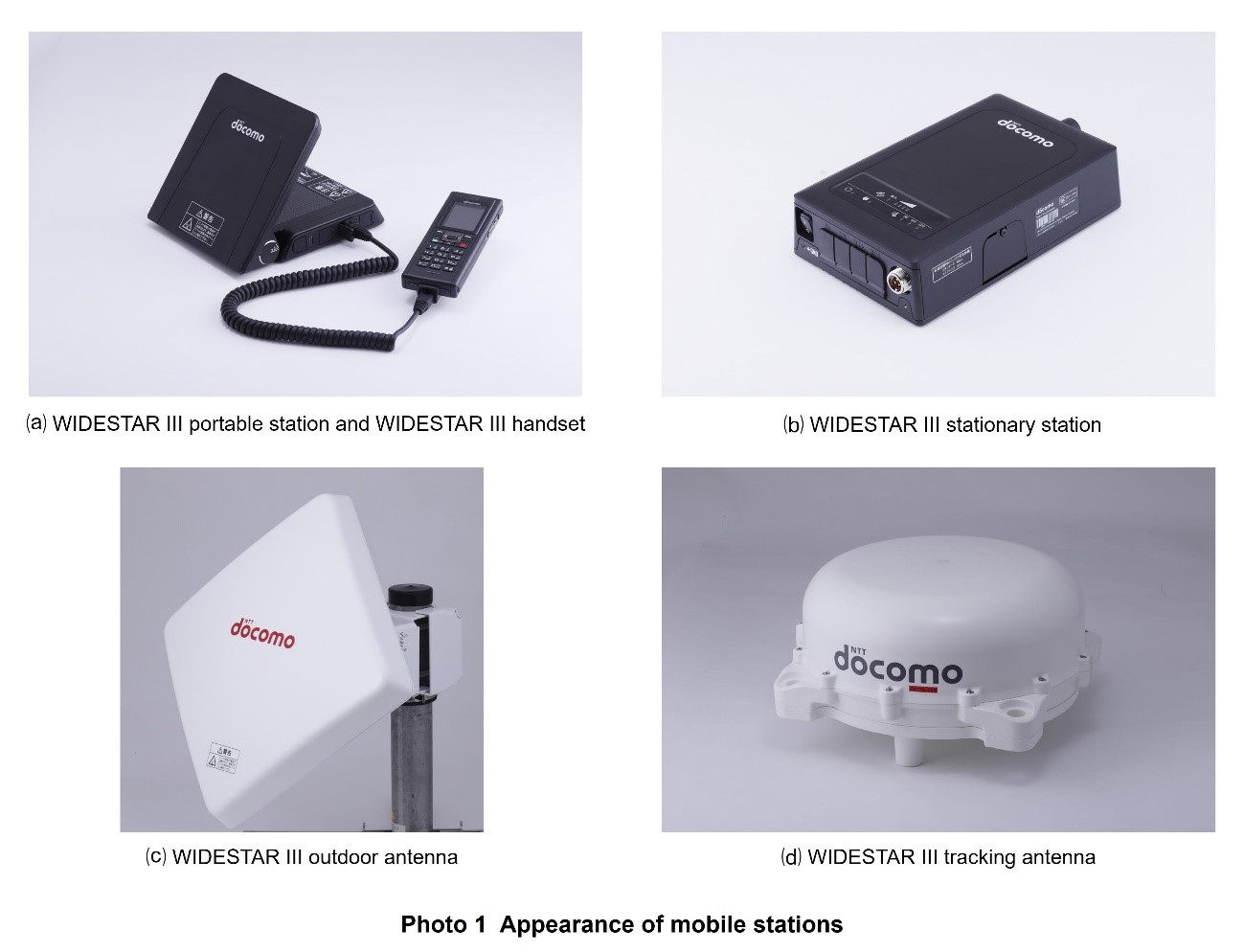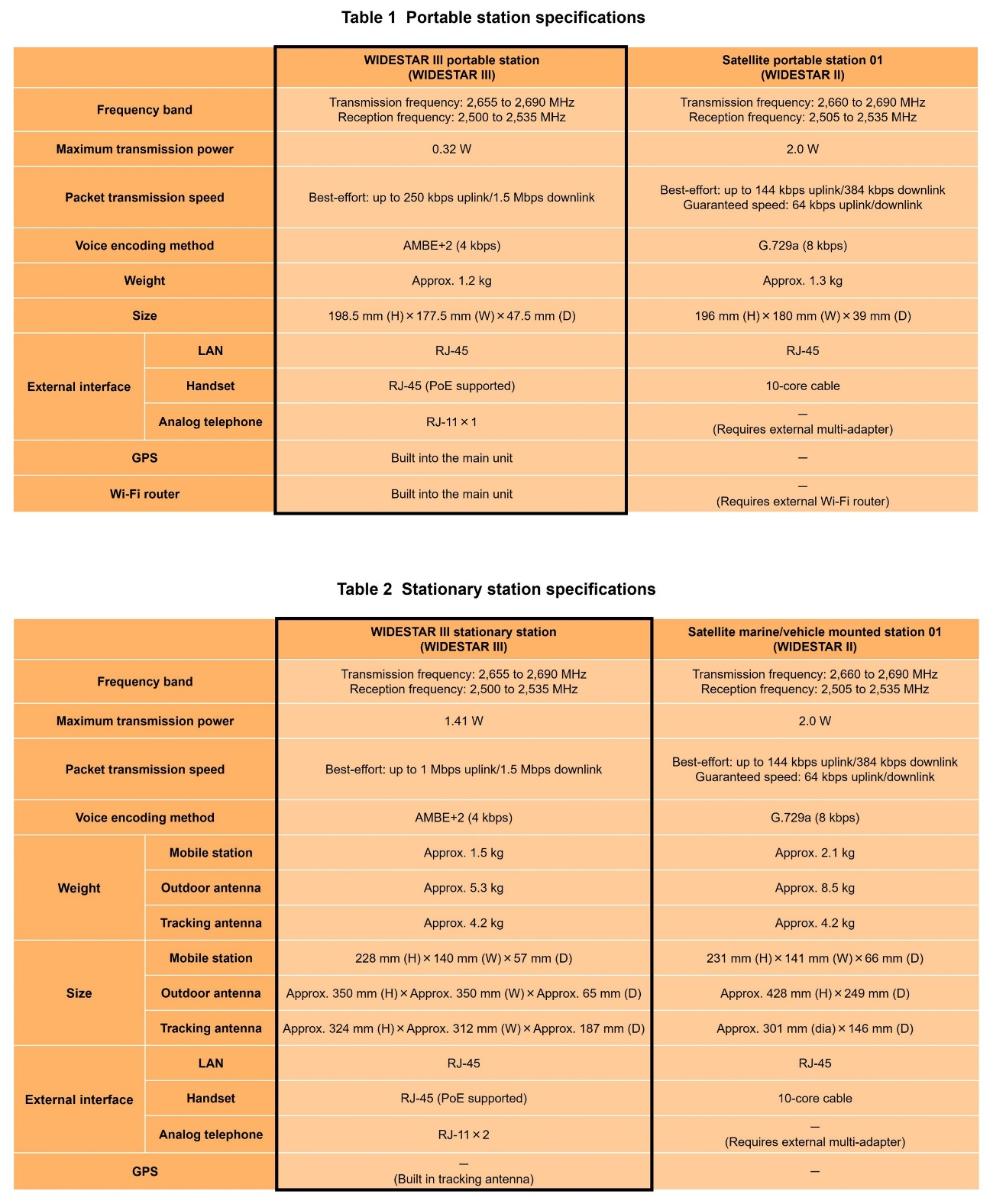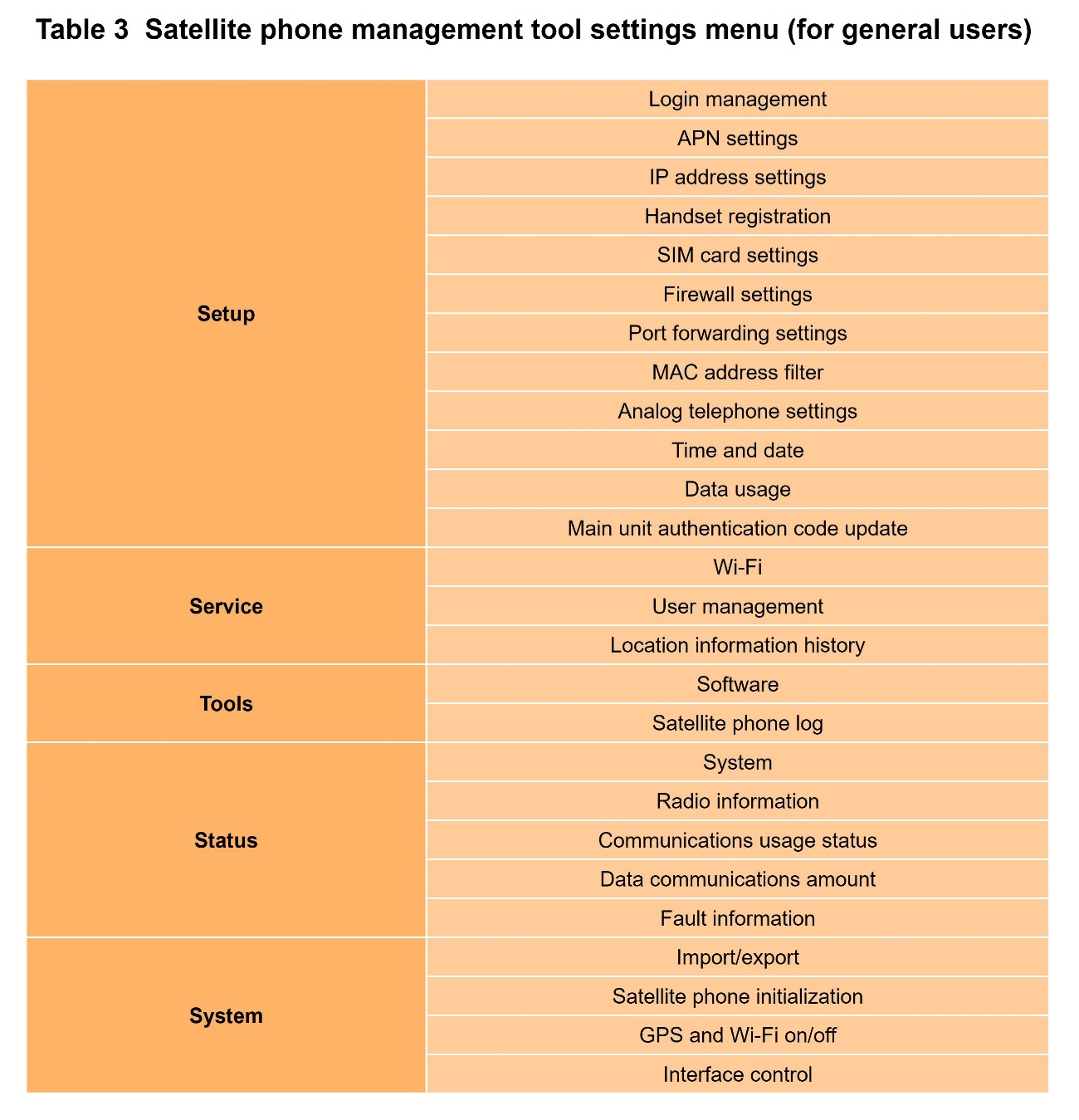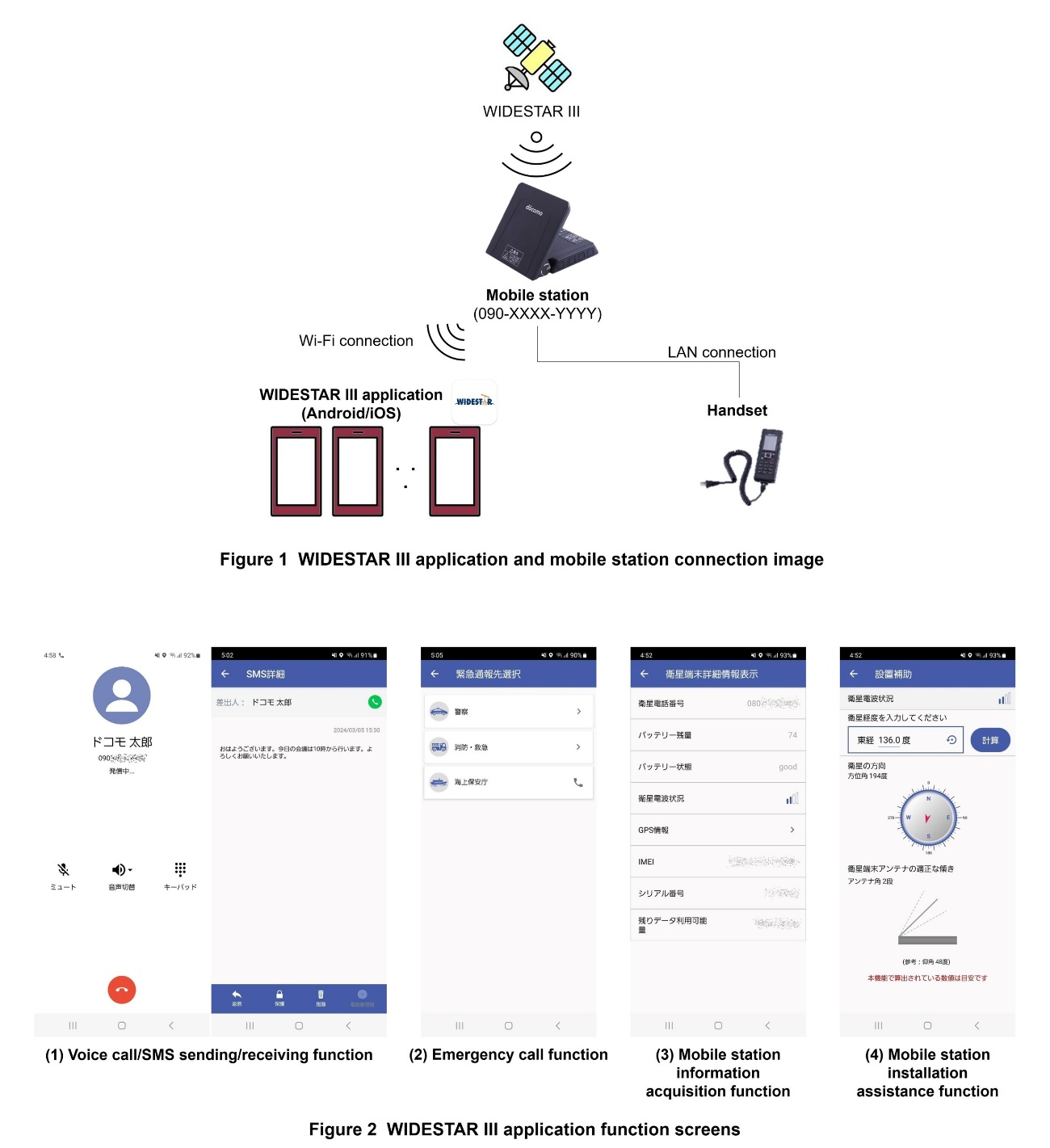Special Articles on Mobile Satellite Communications Systems (1)
WIDESTAR III Satellite Mobile Stations
High Speed Data Communications SMS Smartphone Connection Application
Yukiya Miyashita, Yuji Matsuba, Reiko Tsuchihashi, Kiichi Watanabe, Masanori Yamada, Hirotaka Motegi and Kenta Eguchi
Device-Tech Development Department
Abstract
WIDESTAR III, which began operations in October 2023, is the successor to WIDESTAR II, a domestic mobile satellite communications service that has been in operation since 2010. NTT DOCOMO has developed satellite mobile stations for WIDESTAR III. The newly developed satellite mobile stations have faster communications speeds, enabling data communications at a maximum of 250 kbps uplink and 1.5 Mbps downlink for a portable station, and 1 Mbps uplink and 1.5 Mbps downlink for a stationary station. In addition, SMS use and smartphone linkage via Wi-Fi are also available to meet modern needs.
01. Introduction
-
Launched in 1996 using the S-band*1 (2.6/2.5 GHz band), ...
Open

Launched in 1996 using the S-band*1 (2.6/2.5 GHz band), the domestic mobile satellite communications service “WIDESTAR” was later offered as “WIDESTAR II” from 2010 [1]. NTT DOCOMO has now developed satellite mobile stations (hereinafter referred to as the “mobile stations”) for WIDESTAR III, launched in October 2023 as the successor service to WIDESTAR II.
This article describes the specifications, functional overview, and hardware and software functions of the mobile stations we have developed. In addition, the new mobile stations feature Wi-Fi connectivity for smartphones. This article also describes the functions, configuration, and connection methods of the smartphone app that utilizes this feature.
- S-band: A name for the frequency band from 2 to 4 GHz. WIDESTAR uses the 2.6/2.5 GHz frequency band.
-
2.1. Overview
Open

As with the WIDESTAR II mobile stations, two types of mobile stations were developed for WIDESTAR III: a portable station and a stationary station. These stations support the basic functions of WIDESTAR II mobile stations, as well as Wi-Fi router (portable type only), GPS, and Short Message Service (SMS) functions.
The exteriors of these mobile stations are shown in Photo 1, and specifications are shown in Tables 1 and 2.
As with WIDESTAR II, the 2.6/2.5 GHz frequency bands are used, and the radio connection method is based on LTE.
Voice calls can also be made from a handset connected to the RJ-45 interface*2 on the mobile station or an analog telephone connected to the RJ-11 interface*3. SMS can also be sent and received from the handset and WIDESTAR III application.
For fax communications, WIDESTAR II required a separate fax adapter connection, but WIDESTAR III enables sending and receiving faxes by connecting a fax machine directly to the RJ-11 interface on the mobile stations.
For data communications, multiple PCs can be connected to the RJ-45 interface/Wi-Fi of the mobile stations.
2.2 Features
1) Mobile Station Hardware Functions
(a) External interface
- (1) RJ-45 connector (Ethernet)
While WIDESTAR II has only one RJ-45 connector for LAN, WIDESTAR III has two RJ-45 connectors, one for the handset and one for LAN, and the RJ-45 handset connector supports Power over Ethernet (PoE)*4. The handset of WIDESTAR II was integrated with a cable and connected to the mobile station body with a 10-core connector, but WIDESTAR III uses an RJ-45 supporting PoE as the handset interface, making it more versatile. When connected via a hub supporting PoE, up to five handsets can be connected. - (2) RJ-11 connector (modular jack for analog telephone)
While WIDESTAR II required a dedicated adapter for connecting analog telephones and other equipment, WIDESTAR III allows direct connection of analog telephones and other equipment without an adapter, since both portable and stationary stations are equipped with RJ-11 connectors. Furthermore, since the stationary station is equipped with two RJ-11 connectors, by using NARIWAKE Number Service*5, it is possible to use an analog telephone and a fax machine properly when there is an incoming call, while keeping both the analog telephone and fax machine always connected to the stationary station.
(b) GPS
WIDESTAR III incorporates GPS in the portable station and tracking antenna. With the stationary station, GPS functionality can be used in combination with a tracking antenna.
(c) Wi-Fi
While WIDESTAR II required a dedicated router for Wi-Fi connectivity, WIDESTAR III has a Wi-Fi router function installed in its portable station, enabling direct connection of smartphones and PCs (up to five simultaneous connections per station). In addition, the Wi-Fi smartphone linkage function lets the user make calls, send and receive SMS, and change the main unit settings of the mobile satellite phone (hereinafter referred to as the “satellite phone”) from a smartphone on which the dedicated application described below is installed. Although the stationary station does not have Wi-Fi functionality, it is possible to connect a smartphone or PC in the same way by connecting a Wi-Fi access point.
(d) Tracking antenna
Tracking antennas are used in combination with stationary stations on ships and vehicles to align the beam direction with the satellite. The WIDESTAR III tracking antenna control consists of three functions: initial capture, which detects the satellite direction and directs the beam toward the satellite when the satellite direction is unknown; tracking operation, which corrects directional deviation caused by movement or other reasons after initial capture; and a blockage timer, which monitors shielding time to control timing and switch from tracking operation to initial capture when the antenna is continuously shielded. WIDESTAR III requires all-frequency scan for cell search due to the lack of a perch channel*6 in the LTE-based communications system, resulting in longer cell search time compared to WIDESTAR II. For this reason, we have incorporated methods of minimizing the time for initial capture and reducing opportunities for initial capture as much as possible.
2) Mobile Station Software Functions
(a) Communications method
To reduce communications system development costs and improve efficiency, we developed a proprietary system customized for satellite communications based on LTE, which has a proven track record in global commercial use. Since the system is based on LTE, it basically supports the same functions as LTE, such as communications protocols, handover*7 during communications, cell switching during standby, and communications restriction control, etc. However, since there are features unique to satellite communications, such as larger propagation delay and wider cell coverage than cellular, we customized various timer values to take propagation delay countermeasures and improve bandwidth efficiency.
(b) Services provided
- (1) Voice communications
AMBE+2, an even higher quality audio codec*8 than WIDESTAR II, is used for WIDESTAR III. The system is based on Voice over LTE (VoLTE) *9, with Session Initiation Protocol (SIP)*10 [2]/Session Description Protocol (SDP)*11 [3] for communications control, Real-time Transport Protocol (RTP)*12 [4] for voice packets, and Dual-Tone Multi-Frequency (DTMF)*13 [5][6] for push signals used for item selection in call centers and voice mail services. Since line resources are more severe in satellite communications than in cellular, SIP Signaling Compression (SigComp)*14 [7] is applied to control signals, and Robust Header Compression (RoHC)*15 [8][9] is applied to voice packets, as in VoLTE, to reduce the amount of data involved in voice communications and improve communications efficiency. - (2) Packet communications
By adopting a proprietary system for satellite communications by customizing LTE to improve spectral efficiency*16 compared to WIDESTAR II, we achieved even faster communications speeds, from a maximum uplink speed of 144 kbps and downlink speed of 384 kbps in the previous system (WIDESTAR II), to a maximum uplink speed of 250 kbps (portable stations) and 1 Mbps (installed terminals), and downlink speed of 1.5 Mbps (portable stations and stationary stations) in the new system (WIDESTAR III). This expands the range of solutions that can be introduced beyond WIDESTAR II. - (3) Fax communications
The International Telecommunication Union Telecommunication Standardization Sector (ITU-T)*17 Recommendation T.30*18, which is used for general fixed-line faxes, is used for communications between the fax and mobile stations. On the other hand, T.30 communications are unstable in environments of communications between mobile stations and satellite base stations, where there are large propagation delays and communication interruptions due to radio degradation, which are characteristic of satellite communications. Thus, we adopted the T.38*19 Recommendation, which is customized based on IP and has better delay tolerance than T.30, to achieve highly reliable fax communications even with satellite communications. - (4) SMS
Although WIDESTAR II did not support SMS, WIDESTAR III supports SMS over IP*20, which is based on Internet protocol Multimedia Subsystem (IMS)*21 of LTE to enable SMS on mobile stations. In addition, SIP is used for communications control as in voice communications. - (5) Emergency calling
VoLTE-based emergency calls (110, 119, 118) are supported in the same way as voice communications. In addition, GPS-enabled combinations (portable station + antenna (regardless of type), stationary station + tracking antenna) support the LTE Positioning Protocol (LPP)*22 initial positioning functions (Network Induced-Location Request (NI-LR)*23) and location information acquisition functions (Mobile Terminated-LR (MT-LR)*24) during and after a call, making it possible to notify location information to the emergency call receiving organization (police, fire department, emergency services, and coast guard) in the event of an emergency, not only on land but also at sea.
(c) Satellite phone management tools
Satellite phone management tools can be used by connecting a PC, smartphone, or other device to the mobile station via a wired or wireless (Wi-Fi) connection and accessing the tools from a Web browser on those devices. Satellite phone management tools centrally manage the mobile station-related functions shown in Table 3, such as checking the radio status of the mobile station, Internet connection settings, and various Personal Identification Number (PIN) and function settings. Users can check and change settings.
- (1) Satellite phone log transmission function
The satellite phone log transmission function is equipped to send logs of the communications status of the mobile station to a specified server. Equipped with a function that enables the transmission of satellite phone logs recording the communications status (signal strength, captured cells, etc.) of the customer's declared area and areas to be checked by in-house maintenance personnel, it is possible to promptly check the status of declared areas and improve the efficiency of area check work. - (2) Automatic call generation function (for in-house maintenance personnel)
For in-house maintenance personnel, mobile stations are equipped with an automatic call*25 generation function. The in-house operation center or other organization accesses mobile stations for maintenance purposes remotely and executes the automatic call generation function to collect logs using the aforementioned satellite phone log transmission function. This improves the efficiency of system maintenance work, such as checking satellite system area coverage and connection health. Note that automatic calls can be configured for the connection cell, number of calls, voice call connection destination, number of voice call attempts, voice call duration, and call interval.
2.3 Smartphone application
1) Overview
The WIDESTAR III dedicated smartphone application supports both Android and iOS operating systems and can be installed carrier-free from Google Play and AppStore. In WIDESTAR II, the predecessor of WIDESTAR III, the service was available through a dedicated handset connected to the mobile station. However, in WIDESTAR III, this application enables the service to be used from a smartphone as an alternative to a handset. To use the service, users launch the WIDESTAR III application from their smartphones while connected to the mobile station through Wi-Fi, and log in with a login ID and password set in advance. An image of the connection between the WIDESTAR III application and the mobile station is shown in Figure 1.
2) Functions
The actual application screens for each function of the WIDESTAR III application are shown in Figure 2. The application has four main functions, which are outlined below.
- (1) Voice call/SMS sending/receiving function
The WIDESTAR III application can be used to make voice calls and send/receive SMS via mobile stations. In addition, these functions can be used in conjunction with the phonebook application already installed on the smartphone. - (2) Emergency call function
The WIDESTAR III application is designed for use in the event of a disaster and has a simplified operation flow of emergency call, enabling immediate calling to emergency agencies (police, fire department, emergency services, and coast guard) from the emergency call screen. - (3) Mobile station information acquisition function
Mobile station information such as remaining battery capacity and satellite signal status can be acquired. - (4) Mobile station installation assistance function
It is possible to calculate the satellite direction at the user's current location and guide the orientation and angle of the mobile station antenna so that it points to the satellite.
3) Structure
To provide services for both Android and iOS operating systems in the WIDESTAR III service, we adopted Xamarin*26, a cross-platform that enables efficient development of both Android and iOS applications in parallel, to develop the smartphone application. Cross-platform development allows approximately 80% of the source code to be shared, improving development efficiency and maintainability.
The application consists of four parts: the UI (Xamarin C#) part, the application middleware part, the SIP stack part, and the OS part. The overall application structure is shown in Figure 3, and an overview of each layer is also provided below.
- (1) UI (Xamarin C#) part
The UI (Xamarin Native) prepared on the Xamarin (framework) side for each OS is used to display the layout and dialogs on the application screens. - (2) Application middleware (Xamarin C#)
Consists of three parts: MST client framework, utility framework, and app core framework.- MST client framework is a framework mainly related to mobile station connection, and manages the connection regarding voice call and SMS functions and mobile station settings.
- The utility framework is a framework that brings together many generic processing syntax used throughout the source code as common components.
- The app core framework handles application startup (e.g., permission control), state management (e.g., screen transition control), and data management (e.g., storage of configuration values), which are necessary when building general mobile applications.
- (3) SIP stack part
Mobile stations are connected via SIP sessions, and this framework is for control of connections. Voice calls are controlled by RTP/RTP Control Protocol (RTCP)*27, and data linkage for SMS is performed by using eXtensible Markup Language (XML)*28. - (4) OS part (Android/iOS)
The functions provided by the OS (Android/iOS) are used to acquire location information, manage databases, and manage network (Wi-Fi) connections.
- RJ-45 interface: Connector for connecting 8-pole, 8-core LAN cables.
- RJ-11 interface: Connector for connecting 6-pole, 2-core analog telephone cables.
- PoE: A technology that uses Ethernet LAN cables to supply power to other LAN devices.
- NARIWAKE Number Service: A service that adds another additional number to the basic subscribed number, allowing users to distinguish incoming calls, such as fax and telephone calls.
- Perch channel: A broadcast channel that the terminal scans to locate cells to attach.
- Handover: The communication technology that performs switching between cells and base stations while maintaining communication between the UE and the network.
- Codec: Technology for coding and decoding data such as audio signals.
- VoLTE: Technology to provide VoIP over LTE.
- SIP: A call control protocol defined by the Internet Engineering Task Force (IETF) and used for IP telephony with VoIP, etc.
- SDP: A protocol to describe information, such as IP addresses, necessary for initiating sessions in the IMS. It is also used to describe session information relating to SIP which is a call control protocol.
- RTP: A transmission protocol for streaming video and audio. A type of User Datagram Protocol (UDP) No packet loss prevention measures are taken. Generally used in combination with communication status reports by RTCP.
- DTMF: A method to send audio tones uniquely allocated to each button of a telephone set. Alternatively called tone-signals or push-tones.
- SigComp: A technique for compressing SIP signals specified in Request for Comments (RFC) documents.
- RoHC: A technique for compressing the RTP/IP/UDP header specified in RFC documents.
- Spectral efficiency: The number of data bits that can be transmitted per unit time and unit frequency band.
- ITU-T: The Telecommunication Standardization Sector within the International Telecommunication Union (ITU).
- T.30: A transmission control protocol standardized by ITU-T for G3 fax communications over switched telephone networks and Integrated Services Digital Networks (ISDN).
- T.38: A transmission control protocol standardized by ITU-T for real-time G3 fax communications over IP networks.
- SMS over IP: SMS that sends/receives messages using SIP protocol.
- IMS: A call control procedure that realizes multimedia communications by consolidating 3GPP standardized communications services offered over fixed and mobile networks using SIP, which is a protocol used on the Internet and in Internet phones.
- LTE LPP: A communications method standardized by 3GPP that enables location-based services over LTE.
- NI-LR: When a mobile station user makes an emergency call, the network obtains the current location information of the mobile station user and notifies the LoCation Services Client (LCS Client).
- MT-LR: The ability for the LCS Client to obtain current location information for mobile station users via the network.
- Automatic call: A function that automatically makes outgoing calls by specifying the destination of the call in the satellite phone management tool.
- Xamarin: A development platform using .NET, an open-source application platform supported by Microsoft Corporation, making it possible to create applications that can run on different platforms such as iOS, Android, and Windows.
- RTCP: A protocol for controlling RTP data streams used in combination with RTP. Exchanging information such as bandwidth and delay time over RTCP enables quality management to be performed.
- XML: A markup language proposed by the World Wide Web Consortium (W3C) for describing the meaning and structure of documents and data. It can be extended by user-defined tags.
-
This article has provided an overview of the WIDESTAR III ...
Open

This article has provided an overview of the WIDESTAR III mobile stations and smartphone application. In the newly developed mobile stations, the analog 10-core cable that has been used continuously as a mobile station - handset connection cable since the days of analog car telephones has been replaced by Ethernet cable and Wi-Fi, making it digital after more than 30 years. To improve user convenience in accordance with changing times, the WIDESTAR III mobile stations can be used with smartphones, smartphone applications, and various other peripheral devices, making it possible to easily extend the functionalities of the mobile stations to address a wide range of user needs. In the future, the satellite communications field will further expand and diversify with the addition of more advanced and high-speed space and satellite communications, such as Non-Terrestrial Networks (NTN)*29 and direct satellite communications from smartphones, which have been increasingly discussed in various situations. NTT DOCOMO would like to further expand satellite communications by considering various customer usage scenarios.
- NTN: A network that extends the communications area to diverse locations including the air, sea, and space using non-terrestrial media such as satellites and High-Altitude Platform Stations (HAPS) without limiting the coverage area to land.
-
REFERENCES
Open

- [1] Y. Kiba et al.: “WIDESTAR II Satellite Mobile Station,” NTT DOCOMO Technical Journal, Vol. 12, No. 2, pp. 70-76, Sep. 2010.
 https://www.docomo.ne.jp/english/binary/pdf/corporate/technology/rd/technical_journal/bn/vol12_2/vol12_2_070en.pdf (PDF format:910KB)
https://www.docomo.ne.jp/english/binary/pdf/corporate/technology/rd/technical_journal/bn/vol12_2/vol12_2_070en.pdf (PDF format:910KB) - [2] IETF RFC3261: “SIP: Session Initiation Protocol,” 2002.
- [3] IETF RFC4566: “SDP: Session Description Protocol,” 2006.
- [4] IETF RFC3550: “RTP: A Transport Protocol for Real-Time Applications,” 2003.
- [5] IETF RFC2833: “RTP Payload for DTMF Digits, Telephony Tones and Telephony Signals,” 2000.
- [6] IETF RFC4733: “RTP Payload for DTMF Digits, Telephony Tones, and Telephony Signals,” 2006.
- [7] IETF RFC3320: “Signaling Compression (SigComp),” 2003.
- [8] IETF RFC3095: “RObust Header Compression (ROHC): Framework and four profiles: RTP, UDP, ESP, and uncompressed,” 2001.
- [9] IETF RFC4815: “RObust Header Compression (ROHC): Corrections and Clarifications to RFC 3095,” 2007.
- [1] Y. Kiba et al.: “WIDESTAR II Satellite Mobile Station,” NTT DOCOMO Technical Journal, Vol. 12, No. 2, pp. 70-76, Sep. 2010.







